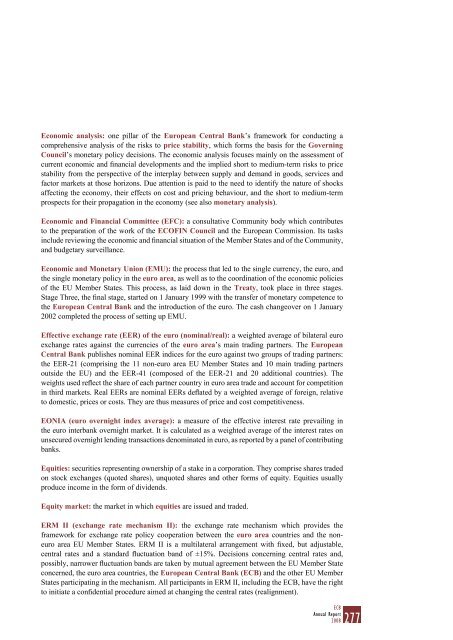ANNUAL REPORT 2008 - Polymer Bank Notes of the World
ANNUAL REPORT 2008 - Polymer Bank Notes of the World
ANNUAL REPORT 2008 - Polymer Bank Notes of the World
Create successful ePaper yourself
Turn your PDF publications into a flip-book with our unique Google optimized e-Paper software.
Economic analysis: one pillar <strong>of</strong> <strong>the</strong> European Central <strong>Bank</strong>’s framework for conducting acomprehensive analysis <strong>of</strong> <strong>the</strong> risks to price stability, which forms <strong>the</strong> basis for <strong>the</strong> GoverningCouncil’s monetary policy decisions. The economic analysis focuses mainly on <strong>the</strong> assessment <strong>of</strong>current economic and financial developments and <strong>the</strong> implied short to medium-term risks to pricestability from <strong>the</strong> perspective <strong>of</strong> <strong>the</strong> interplay between supply and demand in goods, services andfactor markets at those horizons. Due attention is paid to <strong>the</strong> need to identify <strong>the</strong> nature <strong>of</strong> shocksaffecting <strong>the</strong> economy, <strong>the</strong>ir effects on cost and pricing behaviour, and <strong>the</strong> short to medium-termprospects for <strong>the</strong>ir propagation in <strong>the</strong> economy (see also monetary analysis).Economic and Financial Committee (EFC): a consultative Community body which contributesto <strong>the</strong> preparation <strong>of</strong> <strong>the</strong> work <strong>of</strong> <strong>the</strong> ECOFIN Council and <strong>the</strong> European Commission. Its tasksinclude reviewing <strong>the</strong> economic and financial situation <strong>of</strong> <strong>the</strong> Member States and <strong>of</strong> <strong>the</strong> Community,and budgetary surveillance.Economic and Monetary Union (EMU): <strong>the</strong> process that led to <strong>the</strong> single currency, <strong>the</strong> euro, and<strong>the</strong> single monetary policy in <strong>the</strong> euro area, as well as to <strong>the</strong> coordination <strong>of</strong> <strong>the</strong> economic policies<strong>of</strong> <strong>the</strong> EU Member States. This process, as laid down in <strong>the</strong> Treaty, took place in three stages.Stage Three, <strong>the</strong> final stage, started on 1 January 1999 with <strong>the</strong> transfer <strong>of</strong> monetary competence to<strong>the</strong> European Central <strong>Bank</strong> and <strong>the</strong> introduction <strong>of</strong> <strong>the</strong> euro. The cash changeover on 1 January2002 completed <strong>the</strong> process <strong>of</strong> setting up EMU.Effective exchange rate (EER) <strong>of</strong> <strong>the</strong> euro (nominal/real): a weighted average <strong>of</strong> bilateral euroexchange rates against <strong>the</strong> currencies <strong>of</strong> <strong>the</strong> euro area’s main trading partners. The EuropeanCentral <strong>Bank</strong> publishes nominal EER indices for <strong>the</strong> euro against two groups <strong>of</strong> trading partners:<strong>the</strong> EER-21 (comprising <strong>the</strong> 11 non-euro area EU Member States and 10 main trading partnersoutside <strong>the</strong> EU) and <strong>the</strong> EER-41 (composed <strong>of</strong> <strong>the</strong> EER-21 and 20 additional countries). Theweights used reflect <strong>the</strong> share <strong>of</strong> each partner country in euro area trade and account for competitionin third markets. Real EERs are nominal EERs deflated by a weighted average <strong>of</strong> foreign, relativeto domestic, prices or costs. They are thus measures <strong>of</strong> price and cost competitiveness.EONIA (euro overnight index average): a measure <strong>of</strong> <strong>the</strong> effective interest rate prevailing in<strong>the</strong> euro interbank overnight market. It is calculated as a weighted average <strong>of</strong> <strong>the</strong> interest rates onunsecured overnight lending transactions denominated in euro, as reported by a panel <strong>of</strong> contributingbanks.Equities: securities representing ownership <strong>of</strong> a stake in a corporation. They comprise shares tradedon stock exchanges (quoted shares), unquoted shares and o<strong>the</strong>r forms <strong>of</strong> equity. Equities usuallyproduce income in <strong>the</strong> form <strong>of</strong> dividends.Equity market: <strong>the</strong> market in which equities are issued and traded.ERM II (exchange rate mechanism II): <strong>the</strong> exchange rate mechanism which provides <strong>the</strong>framework for exchange rate policy cooperation between <strong>the</strong> euro area countries and <strong>the</strong> noneuroarea EU Member States. ERM II is a multilateral arrangement with fixed, but adjustable,central rates and a standard fluctuation band <strong>of</strong> ±15%. Decisions concerning central rates and,possibly, narrower fluctuation bands are taken by mutual agreement between <strong>the</strong> EU Member Stateconcerned, <strong>the</strong> euro area countries, <strong>the</strong> European Central <strong>Bank</strong> (ECB) and <strong>the</strong> o<strong>the</strong>r EU MemberStates participating in <strong>the</strong> mechanism. All participants in ERM II, including <strong>the</strong> ECB, have <strong>the</strong> rightto initiate a confidential procedure aimed at changing <strong>the</strong> central rates (realignment).ECBAnnual Report<strong>2008</strong>277




![KNOW YOUR NEW GIBRALTAR BANKNOTES - [Home] bThe/b](https://img.yumpu.com/50890985/1/184x260/know-your-new-gibraltar-banknotes-home-bthe-b.jpg?quality=85)
![PAPUA NEW GUINEA - [Home] - Polymer Bank Notes of the World](https://img.yumpu.com/49758743/1/190x143/papua-new-guinea-home-polymer-bank-notes-of-the-world.jpg?quality=85)










